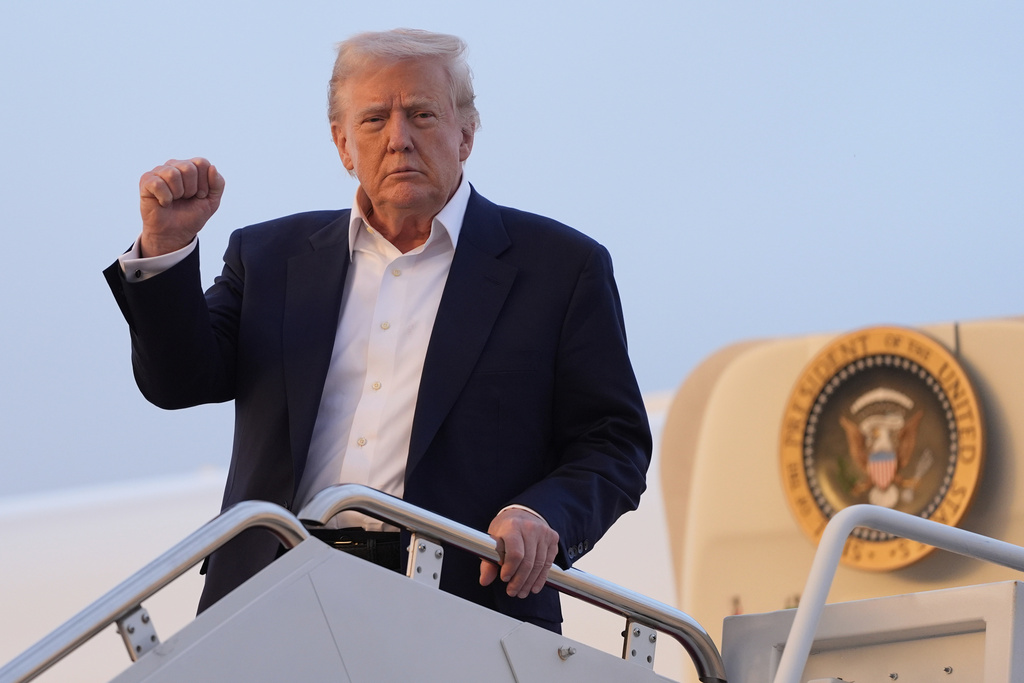

The principle of “checks and balances” is rooted in the Constitution’s design of a national government with three distinct, coequal branches, a system President Donald Trump in his first 100 days has put to the test. We take a look at previous challenges of checks and balances in U.S. history.
Welcome to this week’s edition of AP Ground Game.
Policy changes, but facts endure. AP delivers accurate, fact-based journalism to keep the world informed in every administration. Support independent reporting today. Donate.

President Donald Trump arrives on Air Force One at Joint Base Andrews, Md., Sunday, May 4, 2025. (AP Photo/Manuel Balce Ceneta)
Trump tests America’s ‘checks and balances’
Trump has signed dozens of executive orders, closed or sharply reduced government agencies funded by Congress, and denigrated judges who have issued dozens of rulings against him.
The foundational checks-and-balances fight: President John Adams’ made last-minute appointments before he left office in 1801. His successor, Thomas Jefferson, and Secretary of State James Madison ignored them. When the Supreme Court was asked to compel that Adams’ decisions were honored, Chief Justice John Marshall concluded in 1803 that the commissions became legitimate with Adams’ signature and, thus, Madison acted illegally by shelving them – but stopped short of ordering anything.
During the Civil War, Abraham Lincoln suspended habeas corpus – a legal process that allows individuals to challenge their detention – thus allowing federal authorities to arrest and hold people without granting due process. The Supreme Court’s Roger Taney, sitting as a circuit judge, declared the suspension illegal but noted he did not have the power to enforce the opinion. Congress ultimately sided with Lincoln through retroactive statutes.
Franklin D. Roosevelt met the Great Depression with large federal programs and aggressive regulatory actions, much of it approved by Democratic majorities in Congress. A conservative Supreme Court struck down some of the New Deal legislation as beyond the scope of congressional power. Roosevelt answered by proposing to expand the nine-seat court and pressuring aging justices to retire. Roosevelt disputed his critics’ characterization of “a court-packing scheme,” but not even the Democratic Congress seriously entertained his idea. Read more.
Of note:
Roosevelt ignored the unwritten rule, established by Washington, that a president serves no more than two terms. He won third and fourth terms during World War II, rankling even some of his allies. Soon after his death, a bipartisan coalition pushed the 22nd Amendment that limits presidents to being elected twice.
Vance’s global travels are mix of diplomacy, dealmaking and family time
In the opening months of Trump’s term, Vice President JD Vance has traveled all over the globe — family in tow — to conduct top-level diplomacy for the administration, in addition to taking a number of domestic trips. His international forays have featured a mix of meetings with world leaders, sharply crafted speeches advancing U.S. policy, “soft power” appearances to build goodwill and family time at tourist sites along the way.
Vance’s trips have included a five-day trip to Europe in February, a hastily reorganized trek to Greenland in March and a tour of Italy and India in April that was notable for the vice president’s brief meeting with Pope Francis the day before the pontiff died.
In his first big moment on the world stage in February, Vance pressed Trump’s “America First” message at an artificial intelligence summit in Paris. From there, he attended a security conference in Munich, where Vance left his audience stunned with his lecturing remarks about democracy and scant focus on Russia’s war against Ukraine. Read more.
Of note:
One aim of vice-presidential travel abroad is often soft diplomacy, or the building of favorable attitudes toward the U.S. through imagery and symbolism.
When Vance, with his wife of Indian descent and their children, is photographed at the Taj Mahal, it sends a message of solidarity with that nation. When he visits the Vatican and worships there, it emphasizes common ground with Catholics around the world.
A billionaire and a former bartender emerge as Trump resistance leaders
Many Democrats have been in and out of the spotlight as the party looks for effective counters to Trump. But two disparate figures, Gov. JB Pritzker of Illinois and Rep. Alexandria Ocasio-Cortez of New York, have seen their national profiles rise by delivering messages that excite a demoralized and fractured party.
The governor, a 60-year-old heir to the Hyatt hotel fortune, and the congresswoman, the 35-year-old with working-class roots, both won their first elections in 2018. Both have urged mass resistance and accused their party of not fighting more. Each has stood out enough to draw sharp retorts from Trump loyalists.
But as messengers, Pritzker and Ocasio-Cortez could not be more different. And their arguments, despite some overlap, are distinct enough to raise familiar questions for Democrats: Should they make their challenges to Trump about threats to democracy and national stability, as Pritzker has done, or portray him as a corrupt billionaire exacerbating an uneven economy, as Ocasio-Cortez does? And beyond the message itself, what qualities should the best messenger have?
What links them, said one prominent Democrat, is “assertiveness.” Read more.
Of note:
Adam Green, co-founder of the Progressive Change Campaign Committee, argues Pritzker could be more attractive as a “traitor to his class” in the tradition of President Franklin D. Roosevelt. An East Coast patrician, Roosevelt authored the New Deal’s federal expansion to combat the Great Depression of the 1930s.
Ocasio-Cortez is often criticized by more moderate Democrats, including Michigan Sen. Elissa Slotkin, who has also positioned herself as a thought leader in the party. Slotkin recently suggested the word “oligarchy” didn’t resonate with working-class voters. It was an implicit rebuke of the Ocasio-Cortez-Sanders’ tour.
